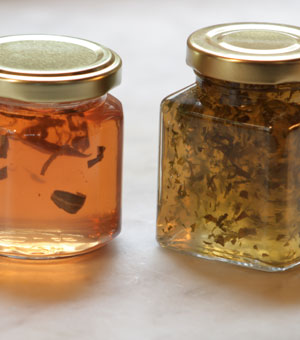
- Switch to Metric
- Switch to Imperial
Ingredients
- 1 kg cooking apples*
- A large bunch of sage or tarragon
- 750 ml cold water
- 125 ml white wine vinegar
- White sugar
- ½ cup extra sage leaves, as small as possible
- * Roughly chopped, skin, cores and all
- ** Or ½ cup finely chopped tarragon leaves
- 2 pounds cooking apples*
- A large bunch of sage or tarragon
- 3 cups cold water
- ½ cup white wine vinegar
- White sugar
- ½ cup extra sage leaves, as small as possible**
- * Roughly chopped, skin, cores and all
- ** Or ½ cup finely chopped tarragon leaves
Herb Jellies
These are simply apple jellies made a little tart by the addition of some cider vinegar. Once the jelly reaches setting point, you let it sit for 10 minutes then stir through some chopped fresh herbs, pour it into little jars and seal. For the sage jelly in the photograph I added the core and peelings of a couple of quinces to the apples and this made the jelly pink rather than green.
Getting ready
- Find an old clean, cotton pillowcase and some strong twine. Work out where you are going to drain the jelly. I have a hook over my bench and some books suggest turning a wooden stool upside down, tying the bag to a broom handle and resting it on the cross bar. The main thing is to have a strong hanging point and enough room underneath to fit the bowl which will catch the juice. You could also just line a large sieve or colander with a clean cotton cloth.
Cooking the fruit
- Put the chopped apples in large preserving pan with the bunch of sage or tarragon the water and the vinegar. Cover the pan and bring to the boil, then cook until the apples are soft, about 10 minutes.
- Put a jelly-bag - or a clean pillowcase, corner downwards - into a large bowl and drape the extra fabric around the bowl. Ladle in the juice and pulp, lift up the edges of the bag and tie it firmly well above the fruit level - this is usually a two-person job.
- Hang the bag over the bowl and leave to drain overnight. Resist the temptation to squeeze the bag and hasten the draining process, since this would make the final jelly cloudy, rather than clear - not a desirable result. Once the juice has drained out, make the jelly within 24 hours or the juice may ferment and will not set.
Making the jelly
- Heat the oven to 150°C, wash some small jars in hot water and put them to drain and dry in the oven. Put a couple of small saucers into the freezer - you'll use them to test the jelly for setting.
- Measure the liquid in the bowl and allow 8 oz / 225 g sugar for each 1 cup / 250 ml of juice.
- Tip the juice into the preserving pan, turn on the heat, add the sugar and stir with a wooden spoon until the sugar is dissolved.
- Turn up the heat and bring to a rapid boil, watching it like a hawk to make sure it doesn't boil over. Adjust the heat if this seems likely, but a quick boil means a better flavoured jelly.
- Start testing for a set after 5 minutes. To do this, put a drop of jelly onto one of your chilled saucers, wait about 15 seconds, and then push a finger gently through the jelly. If the surface wrinkles slightly in front of your finger the jelly is ready. Turn off the heat, remove the hot jars from the oven and put them on a board.
- Skim any froth from the top of the jelly, and let it sit for 10 minutes. It will begin to thicken as it cools and this will stop the herbs from rising to the tops of the jars.
- Stir through the small sage leaves or chopped tarragon, ladle the jelly into a heatproof jug and pour into the jars. Cover the jars immediately and try not to move them until the jelly is cold and set. Label and store in a cool, dark place.